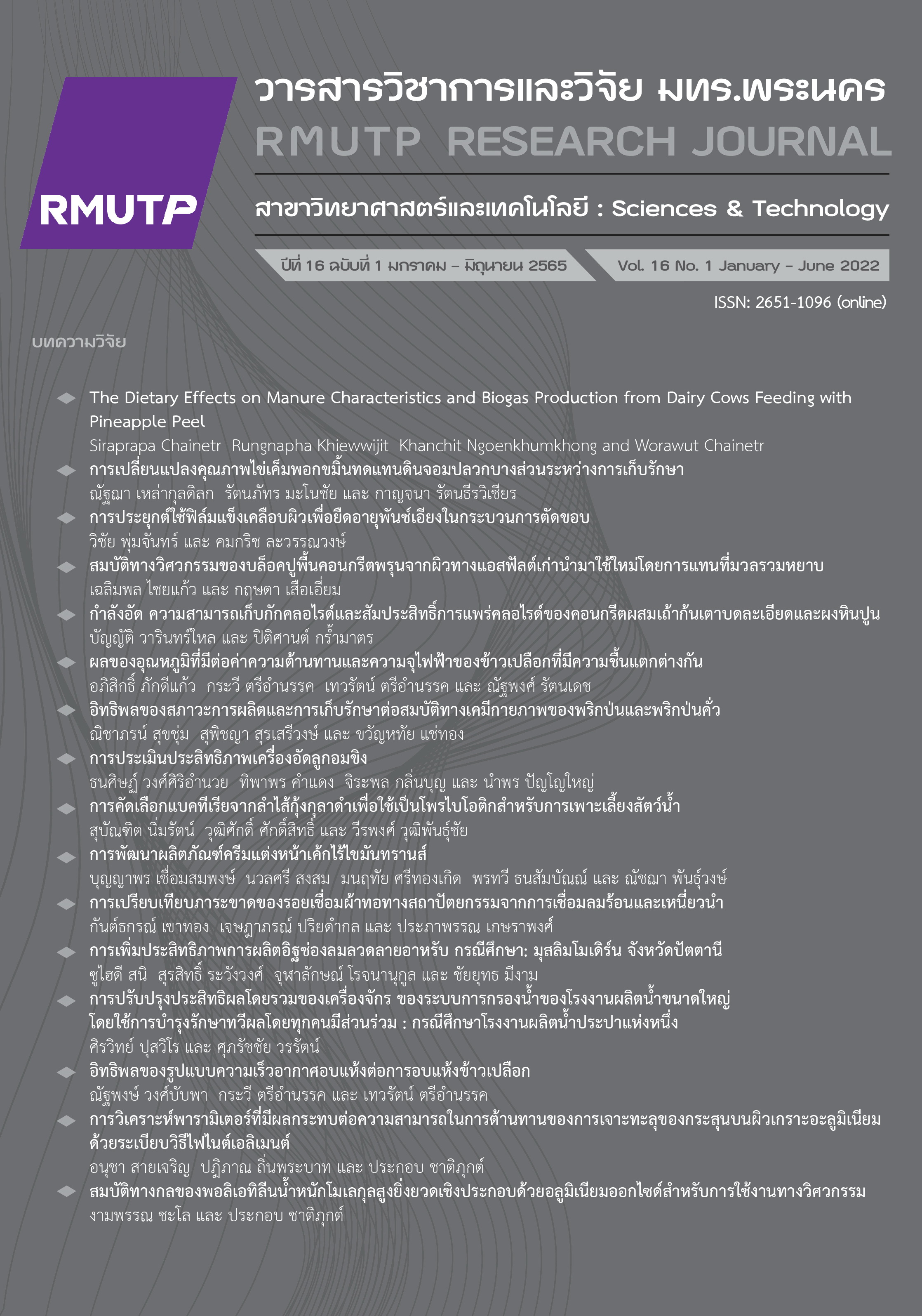Efficiency Evaluate of Ginger Candy Machine
Main Article Content
Abstract
This research objective was to design the ginger candy compression machine and determine the efficiency and capacity for saving time and labor in pressing ginger candy for community enterprise groups Pim Malaherb, Chiang Rai Province. Ginger candy compression machine consists of the main structure, namely the extruder and power transmission systems. The machine was designed with two horsepower motors or 1.5 kilowatts to drive the shaft and to rotate the screw through the flange. This study installs the inverter to control the motor speed at 1,000±10 1,200±10 and 1,400±10 rpm. The extrusion die had an average diameter of 9.7 millimeters. The results found that the motor's speed that was suitable for compression was a Rotational speed of 1,400±10 rpm. When the speed increased, the efficiency and the working rate increased too. The amount of ginger stirred was used at 300 500 600 900 1,000 1,500 2,000 and 3,000 grams. The maximum efficiency was 90.85 percent. The efficiency increased with the amount of ginger stirred. The ginger candy compression machine's engineering economic analysis results found that the machine's operating cost was 18,063.6 baht per year. When considering the machine's operation at 792 hours per year, the payback period was 6 months and 11 days.
Article Details

This work is licensed under a Creative Commons Attribution-NonCommercial-NoDerivatives 4.0 International License.
ลิขสิทธ์ ของมหาวิทยาลัยเทคโนโลยีราชมงคลพระนครReferences
J. Bartley and A. Jacobs, “Effects of drying on flavor compounds in Australian-grown ginger (Zingiber officinale),” Journal of the Science of Food and Agriculture, vol. 80, pp. 209-215, 01/15, 2000.
R. K. Yadav, D. S. Yadav, N. Rai, S. K. Sanwal and P. Sarma, “Commercial prospects of ginger cultivation in north-eastern region,” ENVIS Bull Himal Ecol, vol. 12, no. 2, pp. 1-5, 2004.
K. K. Dash, V. M. Balasubramaniam and S. Kamat, “High pressure assisted osmotic dehydrated ginger slices,” Journal of Food Engineering, vol. 247, pp. 19-29, 2019.
N. Balasundram, K. Sundram and S. Samman, “Phenolic compounds in plants and agri-industrial by-products: Antioxidant activity, occurrence, and potential uses,” Food Chemistry, vol. 99, no. 1, pp. 191-203, 2006.
A. Nath, B. C. Deka, A. K. Jha, D. Paul and L. K. Misra, “Effect of slice thickness and blanching time on different quality attributes of instant ginger candy,” Journal of Food Science and Technology, vol. 50, no. 1, pp. 197-202, 2013.
O. O. Onu and K. J. Simonyan, “Design and construction of a motorized ginger juice expression machine,” Agricultural Engineering International: CIGR Journal, vol. 19, no. 3, pp. 163-16, 2017.
A. Ibrahim and A. P. Onwualu, “Technologies for extraction of oil from oil-bearing agricultural products: A review,” Journal of Agricultural Engineering and Technology (JAET), vol. 13, pp. 58-70, 2005.
P. Polsakkwa, S. Rakarin and T. Khamdaeng, “Optimization of Liquid Removal from Mesona Chinensis Bentham Using a Centrifuge Machine,” Journal of Science & Technology MSU, vol. 38, no. 6, pp. 625-632, 2019.
T. Khamdaeng, T. Wongsiriamnuay, N. Panyoyai, K. Narkprasom and W. Intagun, “Mechanical properties and melting conditions of beeswax for comb foundation forming,” Agricultural Engineering International: CIGR Journal, vol. 18, no. 3, pp. 282-293, 2016.
M. S. Alam et al., “Quality Evaluation of Ginger Candy Prepared by Osmotic Dehydration Techniques,” Food and Nutrition Sciences, vol. 9, pp. 376-389, 2018.
S. Somruethai, R. Jiraporn, and M. Jirawan, “Effect of surimi, emulsified soybean oil and tapioca flour ratio on physico-chemical properties and sensory evaluation in fish emulsion sausage,” in Proceedings of 53rd Kasetsart University Annual Conference: Plants, Animal, Veterinary Medicine, Fisheries, Agricultural Extension and Home Economics Bangkok (Thailand), 2015: The Thailand Research Fund, pp. 1236-1244.


